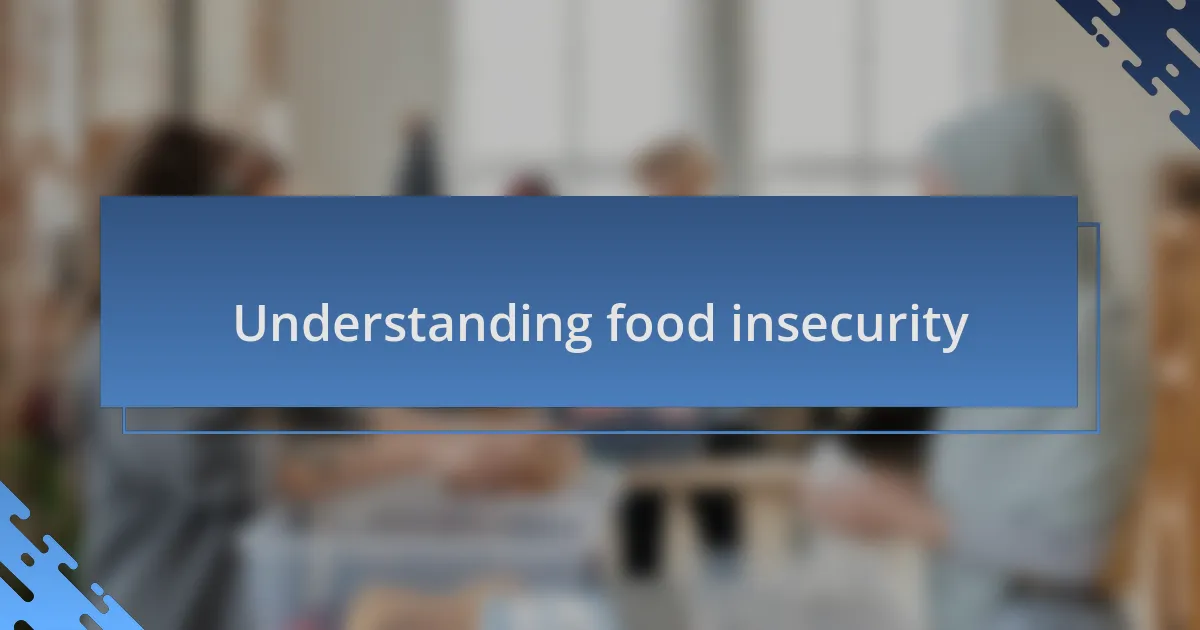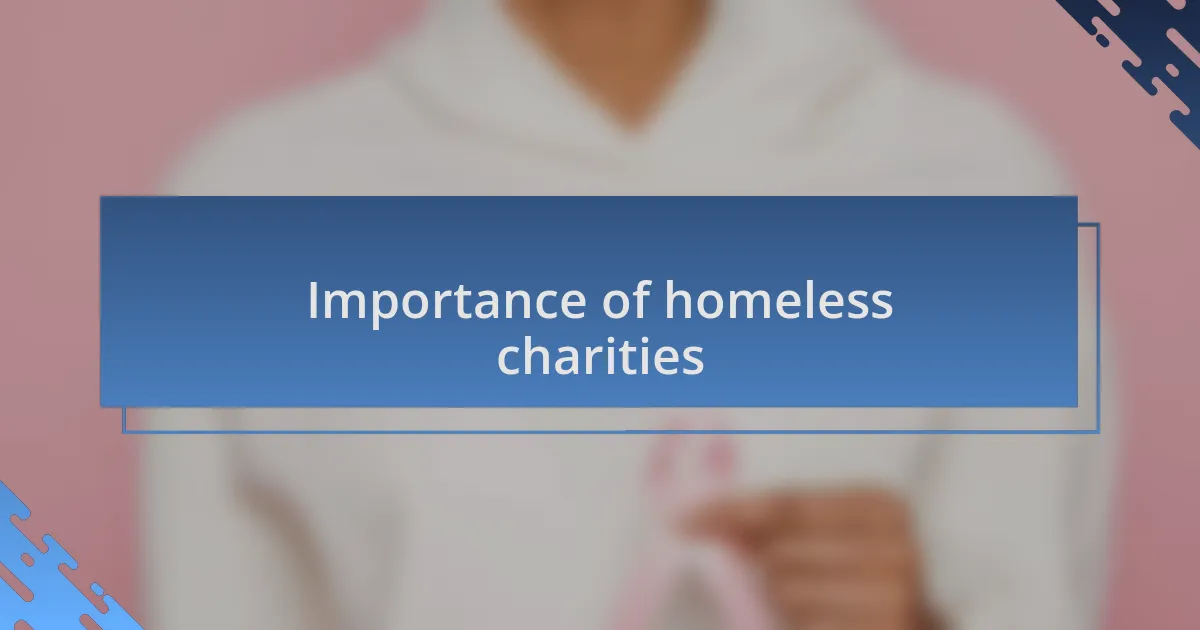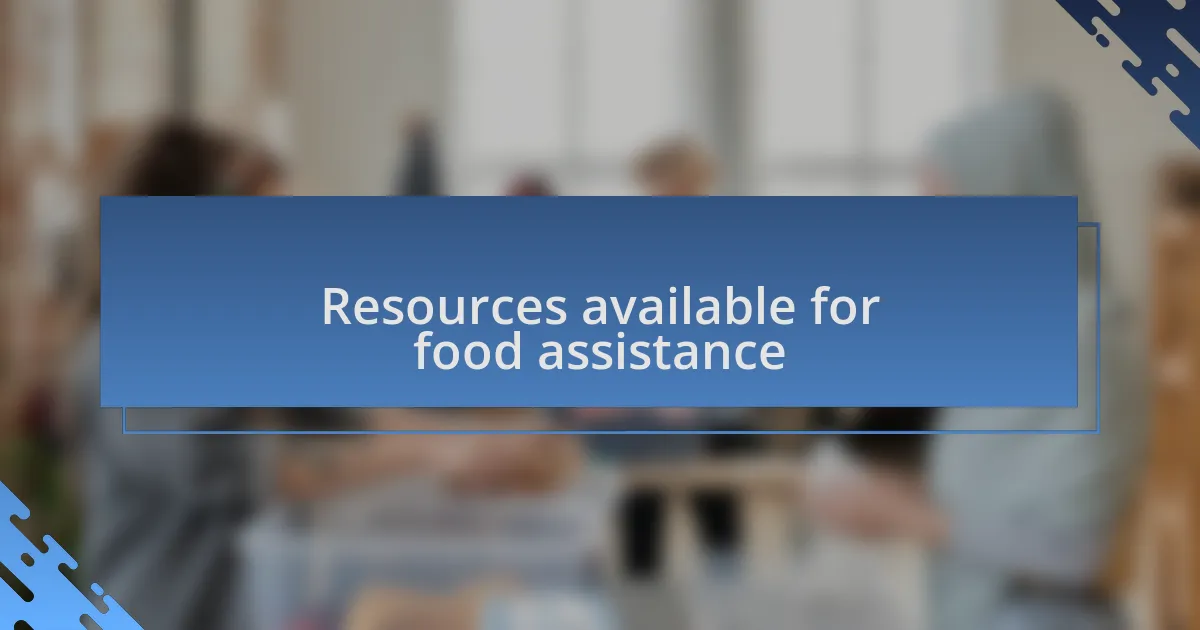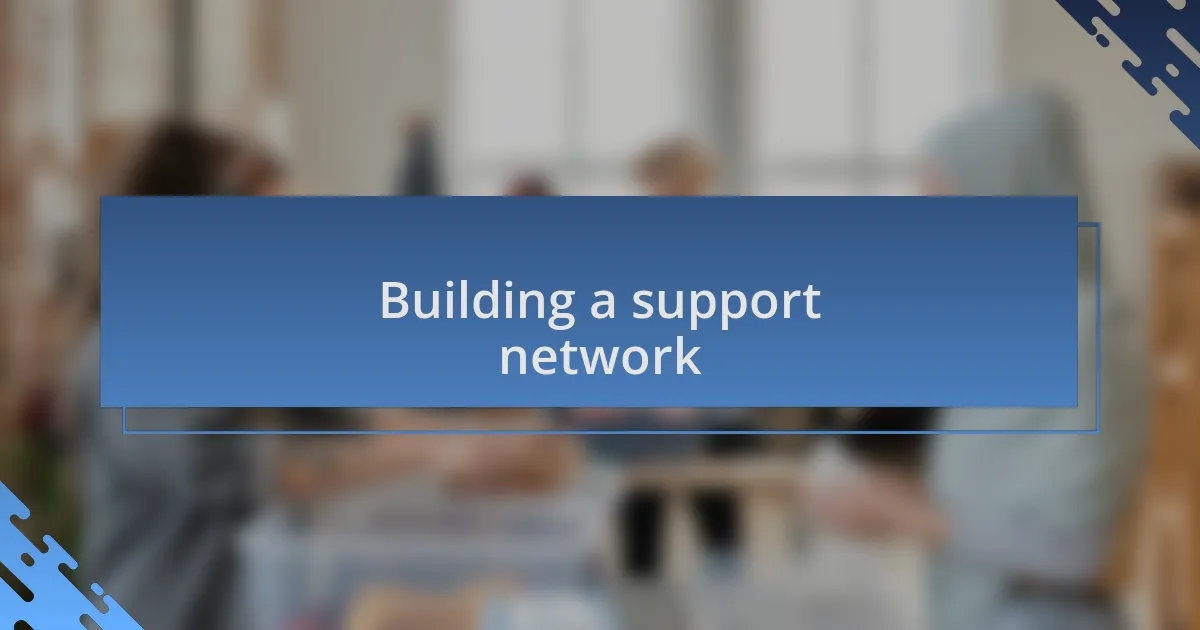Key takeaways:
- Food insecurity is a multifaceted issue linked to poverty and health challenges, resulting in emotional distress and social isolation.
- Homeless charities play a crucial role in alleviating food insecurity by providing not only meals but also support networks and essential resources.
- Accessing local resources, such as food banks and community gardens, can significantly help individuals facing food insecurity, fostering connections and sharing knowledge.
- Building a support network is vital, as it creates a sense of community and shared resilience among those experiencing food scarcity.

Understanding food insecurity
Food insecurity is a complex issue that goes beyond simply not having enough food; it often intertwines with poverty, health challenges, and lack of access to resources. I remember a time when I had to sift through my pantry, hoping to stretch the last remnants of pasta and a can of beans, feeling that familiar knot of anxiety in my stomach—how would I make these few items last?
When I think about food insecurity, I realize it can lead to a deep emotional toll. It often breeds feelings of shame and isolation. Have you ever felt the weight of having to decline social invitations because you couldn’t afford a meal out? I have, and the emotional heartache of feeling different from my peers was a heavy burden to bear.
It’s essential to recognize the ripple effects of food insecurity on health and well-being. I’ve seen friends struggle with the consequences of poor nutrition, from fatigue to chronic illnesses. It’s hard to focus on daily life when basic needs aren’t met. I often wonder, how many people are silently fighting this battle, feeling that they are in it alone?

Importance of homeless charities
When I reflect on the role of homeless charities, it’s clear they serve as lifelines for those grappling with food insecurity. I remember volunteering at a local shelter and witnessing firsthand the immense relief on people’s faces when they received hot meals and groceries. It struck me then how crucial these organizations are in providing not just food but also hope.
These charities don’t just fill stomachs; they build a community. I still think about a young mother I met while distributing food. She shared her story of fear and uncertainty, and how the charity gave her not just provisions, but a supportive network. Just imagine how impactful it is to know you’re not alone in this struggle.
Moreover, homeless charities often provide essential resources beyond food, such as job training and mental health support. Has anyone ever helped you see the light at the end of a dark tunnel? I’ve experienced that through organizations dedicated to lifting people out of poverty, reinforcing the idea that we are all capable of change when given the right tools and support.

Resources available for food assistance
Many local food banks are invaluable resources for those facing food insecurity, often offering a variety of items, from fresh produce to pantry staples. I recall a day when I visited a community food distribution event; the atmosphere was filled with laughter and hope as families chose food items that felt familiar to them. Have you ever seen how something as simple as a meal can bring comfort in difficult times?
In addition to food banks, churches and community centers frequently provide weekly meal programs. I attended one such gathering where volunteers cooked warm, homemade dishes and served them with smiles. It was more than just a meal; it was a moment of connection for everyone involved, demonstrating how food can nourish the spirit as much as it nourishes the body.
Further, organizations like Meals on Wheels deliver nutritious meals directly to those who are homebound. I remember chatting with an elderly gentleman who eagerly anticipated his meals not just for the food, but for the companionship during the delivery. Isn’t it fascinating how something as basic as food provision can create bonds and foster a sense of belonging?

Personal experiences with food insecurity
Facing food insecurity was one of the most challenging periods in my life. I vividly remember rummaging through my kitchen cabinets, hoping to find something substantial to eat. There were days when the realization hit me that dinner might just be a bowl of rice or, worse yet, nothing at all. It’s a sobering experience that makes you appreciate even the smallest meals.
I once had an encounter that forever changed my perspective on food scarcity. During a particularly tough week, I attended a local community meal. As I sat with others, sharing stories over a hot plate of pasta, I couldn’t help but feel a surge of gratitude. It struck me how, in that moment, the table was filled not just with food, but with shared experiences and resilience. Have you ever felt that kind of connection through something as basic as a meal?
Those experiences left a lasting impression on me, reminding me of the importance of support systems. I often think about how a simple act of kindness can transform someone’s day. In one instance, a neighbor offered me leftovers from their family dinner, which was not only food but a reminder that I wasn’t alone in my struggles. It makes me wonder—how many people could benefit from just a little kindness shared over a meal?

Strategies to access food resources
When navigating food insecurity, I found that leveraging local resources was critical. One weekend, I discovered a community food pantry just a few blocks away. The welcoming volunteers there not only provided me with groceries but also shared valuable tips on budgeting meals and using what I had more effectively. Have you ever found unexpected help in your own neighborhood?
Another approach that worked for me was connecting with community gardens. I remember volunteering at one and learning how to grow my own vegetables. The satisfaction of harvesting fresh produce was invigorating, but it also sparked a sense of hope. Isn’t it amazing how nurturing a plant can provide nourishment for both our bodies and our spirits?
I also started attending food distributions hosted by local organizations. At one event, I met a single mother who went to the same distribution. We formed a friendship that led to us sharing recipes and meal ideas, enhancing our cooking and saving money. It was a reminder that food resources can extend beyond the grocery list; they can create a network of support and camaraderie. How often do we overlook the potential for building relationships through our shared experiences of food?

Building a support network
When I started to face food insecurity, I quickly realized that having a support network was essential. A friend of mine introduced me to a local resource group that offered not just food assistance but also emotional support. It felt liberating to connect with others who understood my struggles; have you ever felt the weight lift when you find people who truly get you?
I remember attending a weekly meeting where we shared our challenges and victories. Hearing others talk about their experiences made me feel less isolated. It’s surprising how much comfort can come from a simple acknowledgment that we’re all in this together. Connecting with these individuals created a community where we exchanged advice on local food resources and shared leads on job opportunities too.
Over time, our network grew beyond just sharing meals. We began to organize potluck dinners, where everyone contributed a dish, often from items they had on hand. The laughter and joy shared during those evenings transformed our struggles into a celebration of resilience. Isn’t it incredible how support can turn scarcity into abundance, even just for a moment?